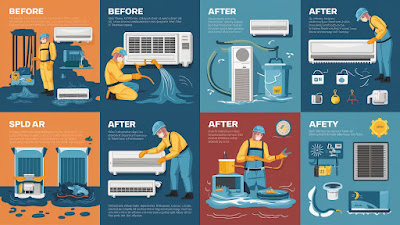When a split air conditioner is submerged during a flood, it is exposed to water, mud and contaminants that can compromise its operation and safety. Recovering and cleaning a device in these conditions requires a series of careful procedures to ensure that it works correctly and safely again. Below, we present a detailed guide for recovering and cleaning a split air conditioner that has been underwater for an extended period.
1. Safety First:
Before starting any procedure, disconnect the external and internal air conditioner units from the electrical power source. Use personal protective equipment, such as rubber gloves and boots, to avoid electrical shock hazards. Make sure the area is dry and free from water before starting to work on the appliance.
2. Removal and Inspection of Units:
Dismantle the indoor unit (evaporator) and the outdoor unit (condenser) of the air conditioner. Take them to a dry, well-ventilated place. Visually inspect both units for visible damage such as corrosion, damaged wiring, or broken components. Take note of any damage for later repairs.
3. Initial Cleaning:
Wash all removable parts, such as filters, panels and housings, using clean water and neutral detergent. Use a soft brush to remove mud and debris from surfaces. For the outdoor unit, use a low-pressure hose to wash the condenser fins, being careful not to damage them. Let all parts dry completely before proceeding to the next step.
4. Disinfection and Detailed Cleaning:
Prepare a disinfectant solution (one tablespoon of bleach for every gallon of water) and use it to clean all interior and exterior surfaces of the units, including the evaporator and condenser coils. Use a soft cloth or sponge to apply the solution and let it sit for a few minutes before rinsing with clean water. Make sure all areas are completely dry before reassembling units.
5. Inspection and Replacement of Components:
After cleaning and drying, inspect all electrical and electronic components of the units. Check wiring, capacitors, terminals and electrical connections. Replace any component that is damaged or corroded. If the fan motor or compressor is damaged, it will need to be replaced. It is highly recommended that a qualified technician perform this inspection and necessary repairs, especially for electronic and cooling system components.
After all parts are cleaned, disinfected, dried and inspected, reassemble the air conditioning units. Connect them again to the electrical power source and turn on the device. Monitor initial operation to ensure there are no unusual noises, cooling system failures, or electrical problems. If the device does not work correctly or presents persistent problems, consult a specialized technician for a detailed evaluation.
Following these detailed procedures can help restore your split air conditioner to working order after a flood, ensuring it is safe for use. However, if the appliance has suffered extensive damage, it may be more economical and safer to consider replacing it with a new one.
